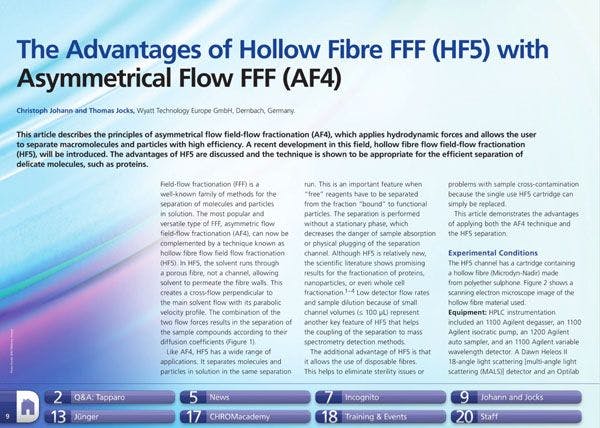Nano LC–MS
Scientists from the University of Michigan Medical Centre (Michigan, USA) have demonstrated the viability of immuno-laser capture microdissection (iLCM) combined with nano liquid chromatography tandem mass spectrometry (LC–MS–MS) for the investigation of various subpopulations of cells within tissues.1 Cancerous tissue can contain different subpopulations of cells and knowing what is within a tumour can help to determine the appropriate course of treatment.
Scientists from the University of Michigan Medical Centre (Michigan,USA) have demonstrated the viability of immuno-laser capturemicrodissection (iLCM) combined with nano liquid chromatographytandem mass spectrometry (LC–MS–MS) for the investigation ofvarious subpopulations of cells within tissues.1 Cancerous tissuecan contain different subpopulations of cells and knowing whatis within a tumour can help to determine the appropriate courseof treatment.
“The work represents a comprehensive proteome analysis of a highlytumorigenic subpopulation isolated from frozen pancreatic cancer tissues atearly stages,” according to Jianhui Zhu, co-author of the paper. He added thatthe findings could advance understanding of cellular and molecular interactions that drive disease.
The scientists investigated two cell populations — pancreatic adenocarcinoma (PDAC) CD24+ stem-likecells and CD24– cells sampled from adjacent normal tissue (ANT). CD24 is a protein found on the surface ofcells and is directly linked to the development and metastasis of pancreatic cancer.
The team was faced with a challenge. By sampling from primary pathology tissue, the opportunity for shotgun proteomic analysis was limited. According to Zhu, approximately 40 nL of tissue was dissected, equal to around 15,000 cells, resulting in a low protein yield. In addition, sample preparation can result in losses of proteins or peptides, impacting the proteome coverage.
LCM was performed to extract pure cell populations, this was followed by filter-aided sample preparation (FASP) method and nano LC–MS–MS.
A total of 2665 proteins were identified, of which 275 were significantly differentially expressed between the PDAC cells and ANC. Protein groups that were differentially expressed had involvement in tumour cell migration and invasion, immune escape, and tumour progression. Candidate proteins were further verified as candidate biomarkers in studies measuring expression in clinical pancreatic cancers.
Zhu said: “Preliminary results are promising and warrant further studies on these key proteins as markers and potential therapeutic targets for this deadly disease.”
Reference
1. Jianhui Zhu, Song Nie, Jing Wu, and David M. Lubman, Journal of Proteome Research12(6), 2791–2894 (2013).
This story originally appeared in The Column. Click here to view that issue.
Polysorbate Quantification and Degradation Analysis via LC and Charged Aerosol Detection
April 9th 2025Scientists from ThermoFisher Scientific published a review article in the Journal of Chromatography A that provided an overview of HPLC analysis using charged aerosol detection can help with polysorbate quantification.
Analyzing Vitamin K1 Levels in Vegetables Eaten by Warfarin Patients Using HPLC UV–vis
April 9th 2025Research conducted by the Universitas Padjadjaran (Sumedang, Indonesia) focused on the measurement of vitamin K1 in various vegetables (specifically lettuce, cabbage, napa cabbage, and spinach) that were ingested by patients using warfarin. High performance liquid chromatography (HPLC) equipped with an ultraviolet detector set at 245 nm was used as the analytical technique.
Removing Double-Stranded RNA Impurities Using Chromatography
April 8th 2025Researchers from Agency for Science, Technology and Research in Singapore recently published a review article exploring how chromatography can be used to remove double-stranded RNA impurities during mRNA therapeutics production.










